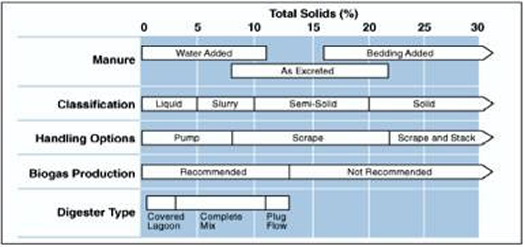Summary of Renewable Natural Gas Production Techniques on Farms
Renewable Natural Gas from Agricultural Wastes is another clean, efficient source of energy.
Biogas, whether as a by-product from digester food processing waste, brewery hops, or more commonly from digested animal waste, is an excellent energy source if the largely methane gas product stream can be purified and stored. If these wastes are not located near an existing gas pipeline, several companies sell the technology to convert biogas from anaerobically digested fuel source into valuable liquid natural gas (“LNG”), which is 600 times denser and readily transported.
Many of the digester biogas utilization projects currently produce electricity or used for heat in a cogeneration project. Now other options for biogas are quickly becoming attractive as market conditions in the energy sector continue to shift dramatically. LNG from biogas can be a locally-produced, clean, sustainable and renewable low-cost source of energy making it an attractive option for dairy operators and local LNG end-users. For instance, each year 250,000 dairy cows in Washington State alone produce over 600,000 tons of manure. If only half of Washington’s dairy manure was anaerobically digested, liquefaction technology could liquefy the ~60% methane gas to produce nearly 35,000,000 gallons of high quality LNG per year. As an alternative to diesel fuel, that LNG would displace over 20,500,000 gallons, or 500,000 barrels of diesel each year.
Manure Management
The management of animal waste is a serious concern for farm operators across the country. Manure management systems typically perform the following functions: collection, transfer, storage, treatment (optional), and hauling. Manure can be handled as a liquid, semi-solid or solid. The total solids content of the manure greatly impacts the collection, transfer and storage options available. Flush or pump systems are used for handling liquid or slurry manure generally containing 1-7% total solids. Flush systems utilize large volumes of water to move manure through gutters to a storage basin or lagoon. Semi-solid or solid manure may contain a certain amount of bedding used to keep the animals comfortable. The scrape method is used for handling manure containing anywhere from 10% to 30% or more of total solids. Manure can be scraped using a small tractor or using mechanical systems such as gutter cleaners or alley scrapers. The type of manure management system employed at a particular dairy farm will determine whether or not an anaerobic digester system is a viable option.
 |
Biogas Recovery/Anaerobic Digester Systems
The production of biogas from animal waste occurs through a process called anaerobic digestion where the organic component of manure is broken down by bacteria that thrive in an oxygen-free environment. The process of anaerobic digestion produces water, nitrogen-rich compost and biogas containing 55-70% methane (CH4), 30-45% carbon dioxide (CO2) and trace amounts of other gases. These digesters are closed vessels that largely hold the odor-causing compounds and the biogas for further processing. The overall process of anaerobically digesting dairy and agricultural waste to produce biogas has numerous environmental benefits including odor control, greenhouse gas reduction, ammonia control and water quality protection.
Anaerobic digesters, also called biogas recovery systems, help livestock producers minimize the environmental impacts associated with management of animal waste while also providing an additional revenue stream if the resulting biogas is cost-effectively converted to a useable source of energy. In 2002, 40 digesters were operational across the U.S. including 29 at dairy farms, nine at swine farms, one at a caged layer farm and one at a duck farm. The growing popularity of anaerobic digesters has led to an increasing drive to improve digester technology. Three primary configurations of anaerobic digesters have been commercialized including the covered lagoon digester, the complete mix digester and the plug flow digester.
Covered Lagoon Digesters
Covered Lagoon Digesters trap and collect biogas from decomposing manure stored in a large lagoon. The lagoon is fitted with an impermeable cover under which microorganisms break down the manure. The gas in then piped out and can be used in a variety of applications. The relatively low cost of implementation and the fact that they require significantly less maintenance in comparison to other designs are significant advantages for covered lagoon digesters. However, the lagoons generally occupy a large footprint that can be problematic for some livestock producers. Covered lagoon digesters work well with high liquid manure generally containing 0.5% to 3% total solids.
Complete mix digesters
Complete Mix Digesters are generally large, cylindrical, above-ground tanks made of steel or reinforced concrete with gas-tight covers to maintain anaerobic conditions. The tanks are heated and utilize a mechanical mixer that periodically churns the manure. This type of digester works best with slurry manure containing 3% to 10% total solids and is compatible with scrape or flush manure management systems.
Plug flow digesters
Plug Flow Digesters are constant volume, flow-through systems generally housed under-ground in long horizontal tanks. Different variations of the plug flow digester design can be found on the commercial market today. Basic designs include a manure collection system, mixing pit equipment and an effluent storage system. This design is used only on dairy farms and requires relatively thick manure, between 11% and 13% solids. Scraped manure must be injected daily and must be free of contaminants such as bedding.
Summary
In comparison to conventional manure treatment systems, anaerobic digesters are a cost-competitive option with added environmental benefits and attractive payback options if the biogas is converted to a useful form of energy such as electric, heat or vehicle fuel.
Additional advantages of using anaerobic digesters in dairy farming operations may include:
* Pest control: Digestion process kills fly eggs in manure
* Weed control: Digestion process kills weed seeds
* Reduction of phosphorous levels in storage lagoons
* Conservation of water in flush manure systems
* Multiple uses for effluent including bedding for animals or nutrient-rich fertilizer

